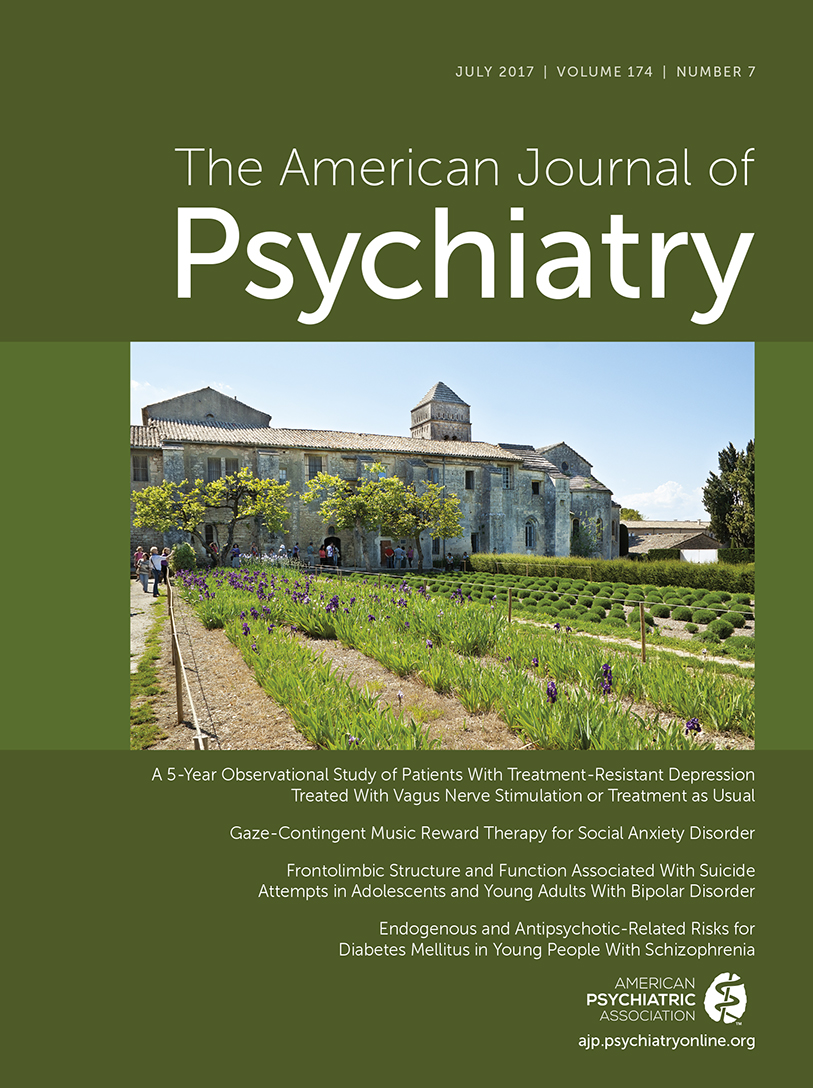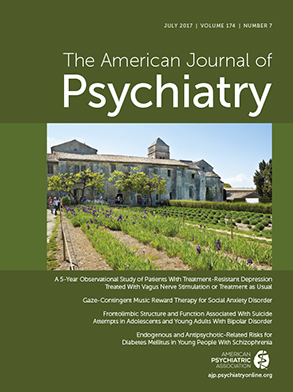Primary Hyperparathyroidism and Psychopathology
The incidence of primary hyperparathyroidism (PHPT) is about 21 cases per 100,000 person-years, and the disorder is usually caused by a solitary parathyroid adenoma (
1). PHPT has traditionally been recognized by its characteristic symptoms, including urolithiasis (“stones”); osteopenia and osteoporosis (“bones”); abdominal cramping, nausea, and peptic ulceration (“moans”); and depression, anxiety, cognitive dysfunction, insomnia, confusion, and personality changes (“psychiatric overtones”) (
1–
3). Although the pathogenesis of psychiatric symptoms in PHPT remains unclear, calcium is thought to figure prominently in determining changes in monoamine metabolism in the CNS, thereby modifying neurotransmission and resulting in alterations in mood and cognition (
3). Generally, the psychopathology emerges after a prolonged period of subclinical hypercalcemia, but the correlation between symptom severity and degree of hypercalcemia is poor (
3,
4) (
Table 1). Of note to the psychiatrist, lithium use has an absolute risk of 10% for PHPT, compared with a 0.1% risk in the general population (
6). This is because lithium increases the calcium set point at which suppression of parathyroid hormone release occurs, thus causing an increase in parathyroid gland volume and hormone secretion (
7,
8).
Interestingly, some studies have reported neuropsychiatric disturbances in cases of mild hypercalcemia due to otherwise asymptomatic PHPT (
2,
9–
11). In samples of patients undergoing parathyroidectomy for PHPT, these disturbances have been identified at a rate of 43.1%–53.0% for anxiety, 33.0%–62.1% for depression, 22.0% for thoughts of death or suicide, 51.9% for anger and irritability, 5.0%–20.0% for hallucinations and delusions, and 37.3%–46.5% for impaired cognition (
1,
9–
12). In fact, it has been noted that there are more neuropsychiatric phenomena in PHPT than is often recognized and that these symptoms are easily missed, particularly in the elderly population (
2).
Considering Neuropsychiatric Symptoms
There have been cases of psychosis attributed to hypercalcemia from PHPT where parathyroidectomy produced resolution (
3,
15). In fact, three randomized controlled trials examining the effect of parathyroidectomy compared with nonoperative intervention on neuropsychiatric symptoms among patients with mild PHPT found modest improvements in the groups undergoing surgical intervention (
16–
18). However, the measured improvements were of uncertain clinical significance, and for patients with PHPT and mild hypercalcemia who do not meet any of the specified criteria (“asymptomatic”), the recommended treatment remains nonoperative (
5). The question then becomes whether or not mild asymptomatic hypercalcemia is truly
asymptomatic if it gives rise to neuropsychiatric disturbances. Moreover, do the risks of parathyroidectomy outweigh the benefits expected from improvement in neuropsychiatric symptoms?
Some investigators have noted improvement or even remission of neuropsychiatric symptoms after parathyroidectomy for PHPT. In a recent prospective study, the investigators observed an improvement in scores on the Patient-Reported Outcomes Measurement Information System after parathyroidectomy in patients with PHPT (
11). Another study found that 1 year after parathyroidectomy, rates of suicidal ideation decreased from 22.0% to 10.7%, anxiety from 49.0% to 22.4%, and depression from 16.7% to 6.6% (
18). In case reports of severe hypercalcemia and PHPT, parathyroidectomy appears to resolve the calcium disturbance and neuropsychiatric symptoms (
12). In a study using the Hospital Anxiety and Depression Scale, not only did severity of symptoms decline after parathyroidectomy, but also the proportions of psychiatric patients with anxiety and depression decreased from 55.6% to 15.4% and 83.3% to 30.8%, respectively (
19). In a case-control study investigating the responsiveness of depression to parathyroidectomy, the patients’ scores on the Patient Health Questionnaire–9 decreased 65.6% over the course of a year after parathyroidectomy (with the greatest decline in the first month), and the proportion of those with at least moderate depression decreased from 43.2% to 7.6% (
20).
For our patient with refractory depression, we proceeded with a course of five ECT treatments and intravenous hydration because of her poor oral intake. The patient’s symptoms and cognition improved dramatically. She became communicative, and her delusions abated. Endocrinology was consulted for management of hyperparathyroidism, and the patient was able to recall being diagnosed with PHPT 3 years earlier; at that time, her case had been deemed inappropriate for operative intervention because of her advanced age. The patient was maintained on oral hydration and weekly ergocalciferol supplementation, after which she showed improvement, and she was eventually discharged to return to her assisted living facility.
Our patient’s advanced age presented a challenge to accurate diagnosis and treatment. Neuropsychiatric symptoms in this age group are less likely to be attributed to PHPT and instead are often assumed to be due to normal aging or dementia (
2). It is interesting to consider whether our patient’s PHPT could have contributed to the recurrence of her psychotic depression and, if so, whether this episode could have been averted had she undergone parathyroidectomy earlier, especially given that she met the surgical criteria. Additionally, PHPT hypercalcemia cure rates by parathyroidectomy are 95%−99% (
21). In 10-year prospective studies of asymptomatic PHPT, 26%−27% of patients ultimately required parathyroidectomy because of the emergence of symptoms (
22,
23). Even so, elderly patients are often not readily referred for surgical evaluation despite the fact that neuropsychiatric symptoms may be a major contributor to disability (
2).
Overall, a comprehensive approach involving treatment of both the psychiatric symptoms and PHPT appeared to be beneficial for our patient’s mental health outcome, consistent with previous reports (
4,
13,
15–
20). Because of the improvement in her neuropsychiatric symptoms after ECT and hydration, the patient will be observed to determine whether her treatment response is durable. If neuropsychiatric symptoms due to or exacerbated by hypercalcemia recur or progress, the potential benefits of parathyroid surgery will be reconsidered and carefully weighed against the possible surgical risks.

